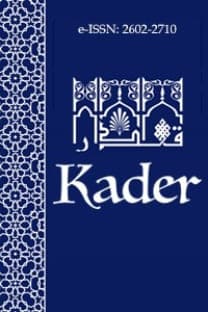KUR’ÂN’IN “KONUŞMACI BOYUTLARI”NIN ANALİZİ - TEKFİR SORUNU: KİM, KİMİ, HANGİ YETKİYLE TEKFİR EDEBİLİR?
Konuşmacı boyutları, Tekfir, Kur’ân bilimleri, Tefsir, Kur’ân’da hitap, Peygamberlerin hitabı
ANALYSIS OF THE “SPEAKER DIMENSIONS” OF THE QUR'ANTEKFIR PROBLEM: WHO, WHO AND WHICH AUTHORIZATION CAN MAKE TEKFIR?
Speaker dimensions, Tekfir, Qur'an sciences, Addressing in the Quran, Tafsir, Addressing the prophets,
___
- Bağdâdî, Ebû Mansûr Abdülkâhir el-Bağdâdî. el-Fark beyne’l-firak.İngilizceye çev. Kate C. Seelye. New York: 1920.
- Cerrahoğlu, İ. Lütfi. Tefsir Usûlü. Ankara: 1971.
- Goldziher, Ignaz. Vorlesungen über den Islam. Darmstadt: y.y. 1963.
- İbn Teymiyye. Kitabü’l-îmân. Dâru’l-furkân, ts.
- İnam, Ahmet. Die theologischen, juristischen und sozialen Dimensionen der Sünde im Koran. Köln: y.y. 2016.
- İnam, Ahmet. “Analyse der Sprecherdimension im Koran: die Thematik der Sündenübertragung Hābīl und Qābīl: Wer sagt was und wer verurteilt wen?”. Johann Wolfgang Goethe-Universität, 2019.
- Izutsu, Toshihiko. The Concept of Belief in Islamic Theology: a semantic analysis of iman and islam. Salem/New Hampshire: 1988.
- Kılıç, Sadık. Kur’ân’a Göre Nifâk. İstanbul: Furkan, 1982.
- Kurtubî, Muhammed b. Ahmed. el-Câmiʿ li-hkâmi’l-Kurʾân, Beyrut: 1985.
- Pampus, Karl Heinz. Studien zum Minderheitenproblem im Islam, Über die Rolle der Ḫāriǧīyaim frühen Islam. Wiesbaden: 1980.
- Râzî, Fahreddîn. Mefâtîhu’l-gayb / et-Tefsîru’l-kebîr. Beyrut: Dâru’l-fikr, 1981.
- Rippin, Andrew. Muslims: Their religious Beliefs and practices. New York: 2005.
- Şehristânî, Ebûl-Feth Muhammed. el-Milel ve’n-nihal. Almancaya çev. Theodor Haarbrücker, Religionspartheien und Philosophenschulen, Halle: 1850.
- Salih, Subhi. Mebâhis fîulûmi’l-Kur’ânn. Beyrut: y.y. 2009.
- Schöck, Cornelia. Koranexegese, Grammatik und Logik: Zum Verhältnis von arabischer und aristotelischer Urteils-, Konsequenz- und Schlusslehre. Leiden: 2005.
- Suyûtî, Celâleddin. el-İtkân fî ulûmi’l-Kur’ân. Suudi Arabistan: Merkezü’d-dirâsâti’l-Kur’âniyye,1496.
- Madelung, Wilferd. “Der Kalām“ in: Grundriß der arabischen Philologie. Yayınlayan: Helmut Gätje, Wiesbaden: 1987.
- van Ess, Josef, Theologie und Gesellschaft im 2. und 3. Jahrhundert Hidschra. Berlin/New York 1991-1997.
- Yavuz, Yusuf Şevki. “Tekfir“. Diyanet İslam Ansiklopedisi. Ankara: 2011.
- Zick Andrew (v.d.). Lasset uns insha’a Allah ein Plan machen. Ed.Michael Kiefer (vd.). Wiesbaden: Springer VS, 2018.
- Yayın Aralığı: 2
- Başlangıç: 2003
- Yayıncı: Mehmet BULĞEN
Kelâm ve Tasavvuf Açısından Kadere İman-Tevekkül İlişkisi
Molla Halil’in (1754-1843) Rü’yetullah Anlayışı
Mâtürîdiyye Geleneğinde Seneviyye/Düalizm Eleştirisi ve İslâm Kaynaklarında Düalizm İnancı
Mehdîlik ve Nüzûl-i Îsâ Tartışmaları -İslam’ın Klasik Çağında Eskatolojik Kurtarıcı İnancı-
Ahlak Tanrı ve Yasa: Din-Ahlak İlişkisi Bağlamında İlahî Emir ve Doğal Yasa Teorileri
Mu’tezile’de Yaratılışın Gayesi ve İlahî Fiillerin Değer Analizi
Hüsün ve Kubuh Niçin Hakikî Değil de İtibârîdir?: Seyfeddîn el-Âmidî Örneğinde Bir İnceleme
Va‘d-Vaîd Konusunda Mâtürîdî’nin Mu‘tezile’ye Yönelttiği Eleştiriler
